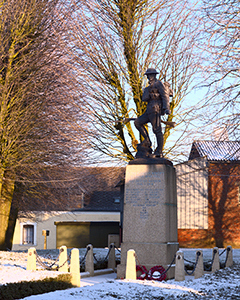Flers–Courcelette
 The statue in the center of this tiny, anonymous village in northern France is remarkable for three reasons:
The statue in the center of this tiny, anonymous village in northern France is remarkable for three reasons:
First, it commemorates a foreigner–the British Tommy, or infantry foot-soldier, who fought and died by the thousands in this section of the 1916 Somme Offensive in World War I. The French don’t erect a lot of statues to foreigners.
Second, in a war famous for its utter indifference to the fate and heroics of the common soldier, this village forewent the usual memorial to some general who had spent the war comfortably ensconced miles from the front in favor of this simple reminder of exactly who bore the brunt of the fighting.
But the third and most surprising reason for wondering about this bronze Tommy is that he stands where the first armored tank in history was offloaded on September 15, 1916, and sent lumbering on its caterpillar tracks to the nearby front. Not a sign or mention anywhere in the village of the then-top-secret British invention that, along with the airplane, defined warfare in the twentieth century.
The British, led by one of the least talented Generals in history, Sir Douglas Haig, had no real clue about the offensive potential of their weapon and envisioned it as a sort of land battleship for use as infantry support. After the initial surprise, the Germans quickly neutralized the nine (out of forty-nine) vehicles that didn’t break down on their own along the way. The battle netted a gain of two kilometers at a cost of 29,376 lives, but as usual on the Western Front in World War I, no Generals were fired.
In a perverse classification worthy of Freud, the British divided their early tank designs into Male (carrying large cannons) and Female (nothing but machine guns). The earliest design was called the Little Willie, but it was the Mother version and her descendants that eventually conquered the world.
Filed under: Travels Tagged: France, Travel




